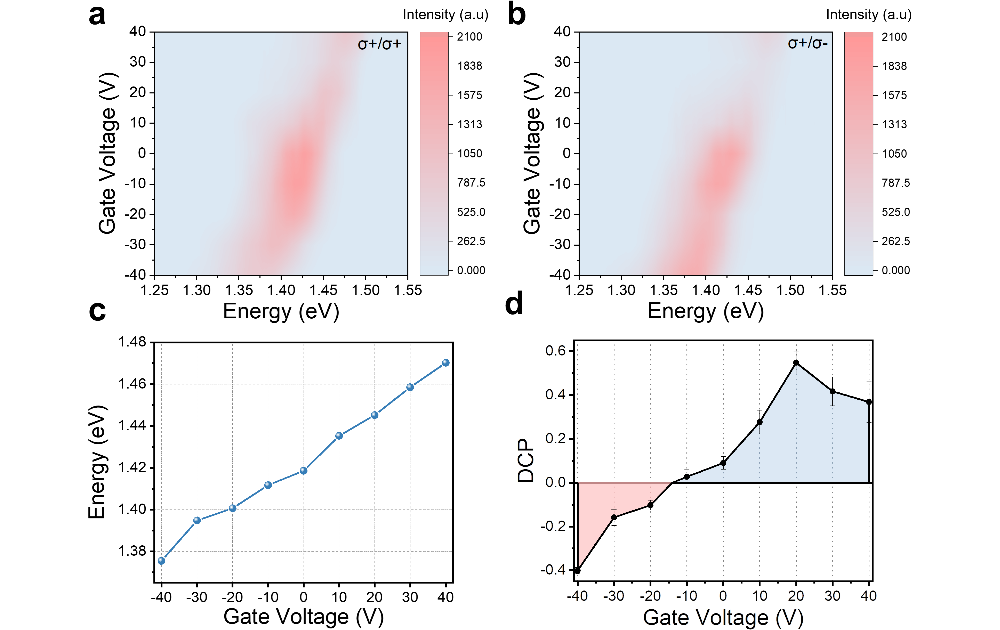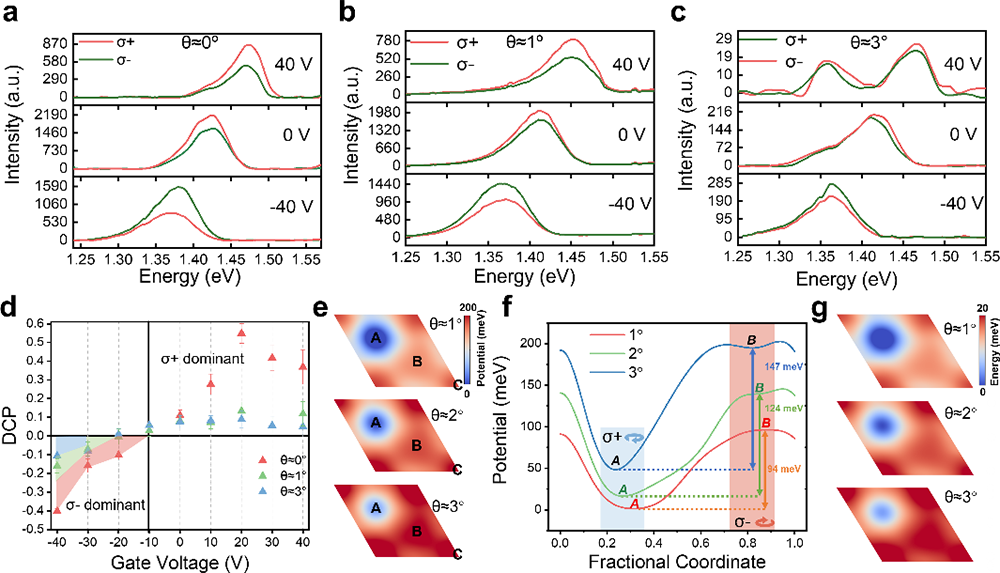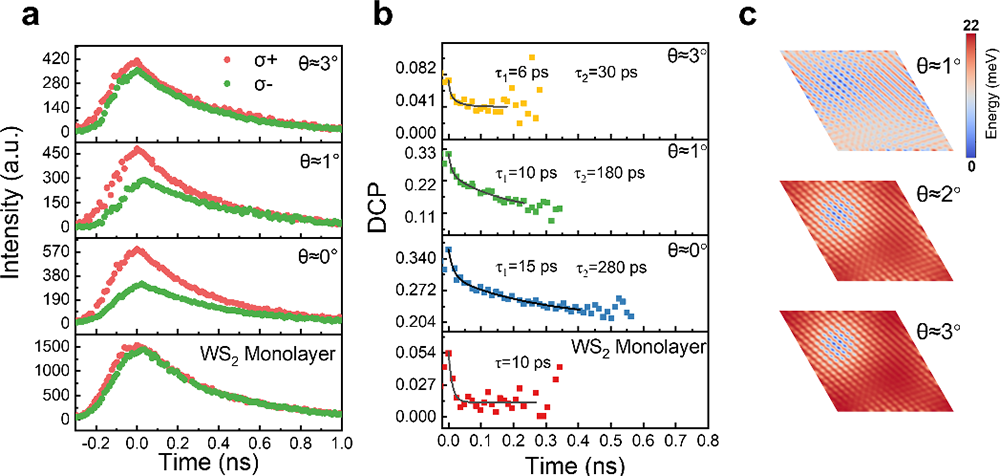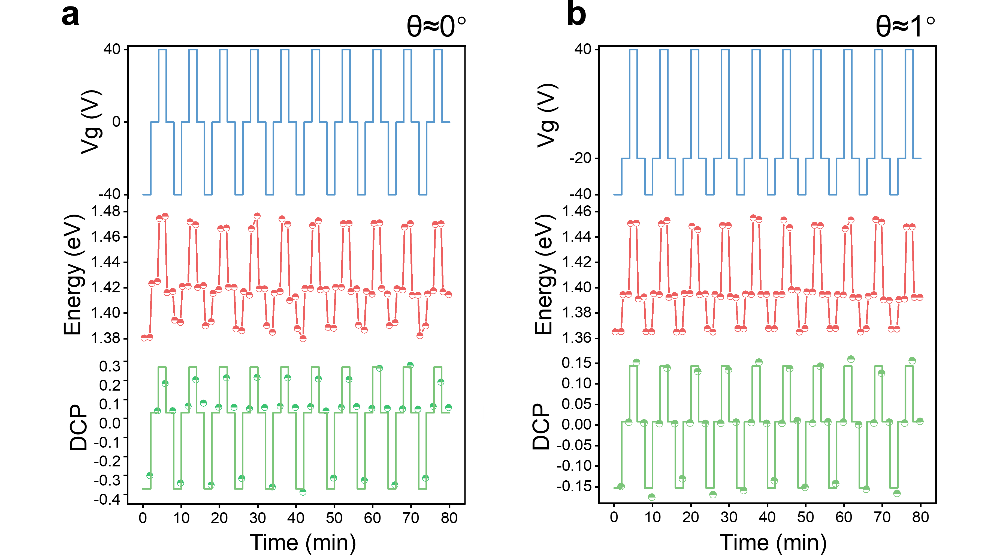Twist-Angle in Moiré Lattice Controls Valley Polarization Switching in Heterostructures
Date:20-05-2024 Print
On May 16th, Beijing time, Professor Can Wang from the Institute of Physics, Chinese Academy of Sciences and Professor Xiulai Xu from Peking University jointly published a research article in the leading journal "Science Advances." The study demonstrates for the first time the dependence of valley polarization switching and polarization degree on the moiré period through a twist engineering in electrically controlled transition metal dichalcogenide (TMD) heterobilayers (hBLs).Van der Waals (vdW) hBLs have caught much attention due to their electronic energy band structures and diverse physical properties for potential valley-based optoelectronic applications. The moiré pattern between different monolayers in vdW heterostructures naturally results in a nanoscale periodic potential, which provides a unique opportunity to implement the next generation valleytronic devices.
Twist engineering is a powerful tool to manipulate the valley degrees of freedom of interlayer excitons (IXs). It provides an extra freedom to control the excitonic potential, thereby enhancing the controllability of valley properties. However, up to now, the twist-angle dependent control on excitonic potential and valley polarization has not been investigated in electrically controlled heterostructures.
The researchers demonstrate that the valley polarization of IXs can be effectively controlled by adjusting the twist angle. Both the degree of circular polarization (DCP) and the polarization switching are electrically controlled in fabricated WSe2/WS2 heterostructure devices with different moiré period, which is determined by the twist angle.
The physical mechanisms of twist angle dependent DCP have been experimentally studied from both intra-layer and inter-layer perspectives. A lower interlayer excitonic potential at local minima caused by a larger moiré period leads to the confinement of more excitons resulting in enhanced DCP. Additionally, an increase in intralayer electron-hole (e-h) exchange interactions at a large angle results in a decrease of intralayer valley lifetime, and a reduced initial intralayer valley polarization, ultimately leading to a reduction of interlayer valley polarization.
By considering the dependence of excitonic potential difference on the moiré period, theoretical calculations based on the first principle theory shows that the difference of excitonic potential between two minima increases with the twist angle, leading to a higher external bias for devices with a larger twist angle to switch the polarization. Based on this polarization switching, the team has further demonstrated a valley-addressable encoding device, offering a platform for future non-volatile memory.
This study entitled "Twist-angle dependent Valley Polarization Switching in Heterostructures" was published on Science Advances. Professor Can Wang and Professor Xiulai Xu are the corresponding authors. Danjie Dai (PhD candidate from Institute of Physics, Chinese Academy of Sciences) is the first author.
The study was supported by the National Key Research and Development Program of China and National Natural Science Foundation of China.

Fig.1 Device characterization of WSe2/WS2 hBLs. (Image from Science Advances)

Fig.2 Electrical control of the IXs in the device with θ≈0°. (Image from Science Advances)

Fig.3 Twist angle dependent polarization properties. (Image from Science Advances)

Fig.4 Intralayer exciton valley dynamics in twisted hBLs. (Image from Science Advances)

Fig.5 Valley optical addressing in electrically controlled twist heterostructures. (Image from Science Advances)
Contact:
Institute of Physics
WANG Can
Email:canwang@iphy.ac.cn
Key words:
Transition metal dichalcogenides; Interlayer excitons; valley polarization switching; Twist engineering
Abstract:
The twist engineering of moiré superlattice in van der Waals heterostructures of transition metal dichalcogenides can manipulate valley physics of interlayer excitons (IXs), paving the way for next-generation valleytronic devices. However, the twist angle–dependent control of excitonic potential on valley polarization is not investigated so far in electrically controlled heterostructures and the physical mechanism underneath needs to be explored. Here, we demonstrate the dependence of both polarization switching and degree of valley polarization on the moiré period. We also find the mechanisms to reveal the modulation of twist angle on the exciton potential and the electron-hole exchange interaction, which elucidate the experimentally observed twist angle–dependent valley polarization of IXs. Furthermore, we realize the valley-addressable devices based on polarization switch. Our work demonstrates the manipulation of the valley polarization of IXs by tunning twist angle in electrically controlled heterostructures, which opens an avenue for electrically controlling the valley degrees of freedom in twistronic devices.

